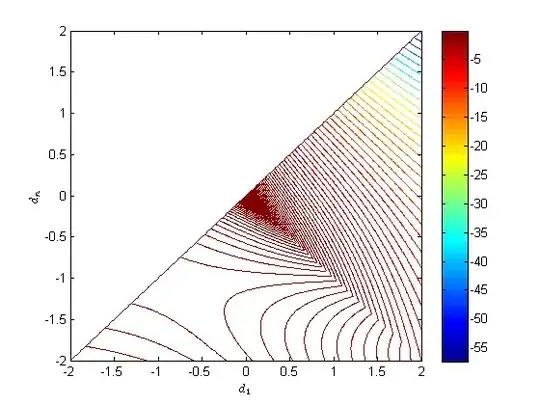Here's an actual proof. It is inspired by one I found on page 116 of "First-Order Methods in Convex Optimization", although the book builds on a lot of theory that isn't really necessary when we are only interested in $L(x)$, so I cut out all of that and reduced it to the essential steps.
As the question notes, we are interested in proving 1-smoothness of the symmetric softmax. To that extent, first define in general terms what we mean by L-smoothness:
Definition ($L$-Smoothness, somewhat informal): Let $f: \mathbb{R}^n \to \mathbb{R}$ be some function and consider some norm $\lVert\cdot\rVert$ on $\mathbb{R}^n$. $f$ is $L$-smooth if it is differentiable and $\lVert \nabla f(x) - \nabla f(y)\rVert_* \le L \lVert x - y \rVert$, where $\lVert\cdot\rVert_*$ is the dual norm defined for the dual space ${\mathbb{R}^n}^*$ of $\mathbb{R}^n$ through $\lVert v \rVert_* = \max_x \{ \langle v, x \rangle \mid \lVert x \rVert = 1 \}$ for $v \in {\mathbb{R}^n}^*$.
Now in our case, $\lVert\cdot\rVert$ is the supremum norm, and its dual norm is the 1-norm, which shows that 1-smoothness is indeed the property we are interested in. We make use of the following lemma, proved at the end:
Lemma: If $f$ is convex, then $f$ is $L$-smooth if $\langle d, \nabla^2 f(x) \cdot d \rangle \le L \lVert d \rVert^2$ for all $d \in \mathbb{R}^n$.
(As an aside: The proof hence proceeds exactly as in this paper, Proposition 4, but with different norms)
To simplify the calculation, we will prove a stronger result, namely 1-smoothness of the unsymmetric softmax $S(x) = \log\left( \sum_i e^{x_i} \right)$, because as user24121 observes, we can always plug in $x = [x_1, \ldots, x_n, -x_1, \ldots, -x_n]$ to obtain the symmetric softmax. After some calculation, we see that the Hessian of $S$ is given by
$$
\nabla^2 S(x) = \mathrm{diag}(\sigma(x)) - \sigma(x)\sigma(x)^T
$$
where
$$
\sigma(x)_i = \frac{e^{x_i}}{\sum_j e^{x_i}}
$$
And now the computation is straightforward:
\begin{align}
d^T \nabla^2 S(x) d &= d^T \mathrm{diag}(\sigma(x))d - (\sigma(x)^Td)^2 \\
&\le d^T \mathrm{diag}(\sigma(x))d \\
&\le \lVert d \rVert_\infty^2 \lVert \sigma(x) \rVert_1 \le \lVert d \rVert_\infty^2
\end{align}
The only thing left to do now is to prove the lemma:
Proof of the Lemma: By Taylor's Theorem, for any $x, d \in \mathbb{R}^n$, there exists $\xi \in \mathbb{R}^n$ such that
$$
f(x + d) = f(x) + \nabla f(x)^T d + \frac12 d^T \nabla^2 f(\xi) d \overset{\text{assumption}}\le f(x) + \nabla f(x)^T d + \frac{L}{2} \lVert d \rVert^2
$$
We continue by proving that any $f$ satisfying the inequality is $L$-smooth. To do so, we must overcome the hurdle that we only have expressions of the form $\langle \nabla f(x + d), d \rangle$, but the definition of the dual norm requires the second argument to be independent of the first. To get around this, we take a detour via the Bregman distance:
Let $D_f(x, d) = f(x + d) - f(x) - \nabla f(x)^T d \le \frac{L}{2}\lVert d \rVert^2$ (this is the Bregman distance, although we do not require $f$ to be strictly convex). Note that because $f$ is convex, $f(x + d) \ge f(x) + \nabla f(x)^Td$ and hence $D_f(x, d) \ge 0$ for all $d$. At the same time, for any $\delta \in \mathbb{R}^n$,
$$
D_f(x, d + \delta) = f(x + d + \delta) - f(x) - \nabla f(x)^T (d + \delta)
$$
Bounding $f((x + d) + \delta)$ through the bound at the start of this proof yields
\begin{align}
D_f(x, d + \delta) &\le f(x + d) - f(x) - \nabla f(x)^T (d + \delta) + \nabla f(x + d)^T \delta + \frac{L}{2}\lVert \delta \rVert^2 \\
&= D_f(x, d) + \langle \nabla f(x + d) - \nabla f(x), \delta \rangle + \frac{L}{2} \lVert \delta \rVert^2
\end{align}
Now with the very specific choice of $\delta = -\frac{\lVert \nabla f(x + d) - \nabla f(x) \rVert_*}{L} v$ for any $v \in \mathbb{R}^n$ with $\lVert v \rVert = 1$ and $\langle \nabla f(x + d) - \nabla f(x), v \rangle = \lVert \nabla f(x + d) - \nabla f(x) \rVert_*$, we can compute
\begin{align}
0 &\le D_f(x, d + \delta) \le D_f(x, d) - \frac{\lVert \nabla f(x + d) - \nabla f(x) \rVert_*}{L} \langle \nabla f(x + d) - \nabla f(x), v \rangle + \frac{1}{2L} \lVert \nabla f(x + d) - \nabla f(x) \rVert_*^2 \\
&= D_f(x + d) - \frac{1}{2L} \lVert \nabla f(x + d) - \nabla f(x) \rVert_*^2
\end{align}
Hence
$$
\frac{1}{2L} \lVert \nabla f(x + d) - \nabla f(x) \rVert_*^2 \le D_f(x + d) \le \frac{L}{2} \lVert d \rVert^2
$$
Multiplying by $2L$ and taking the square root completes the proof.
